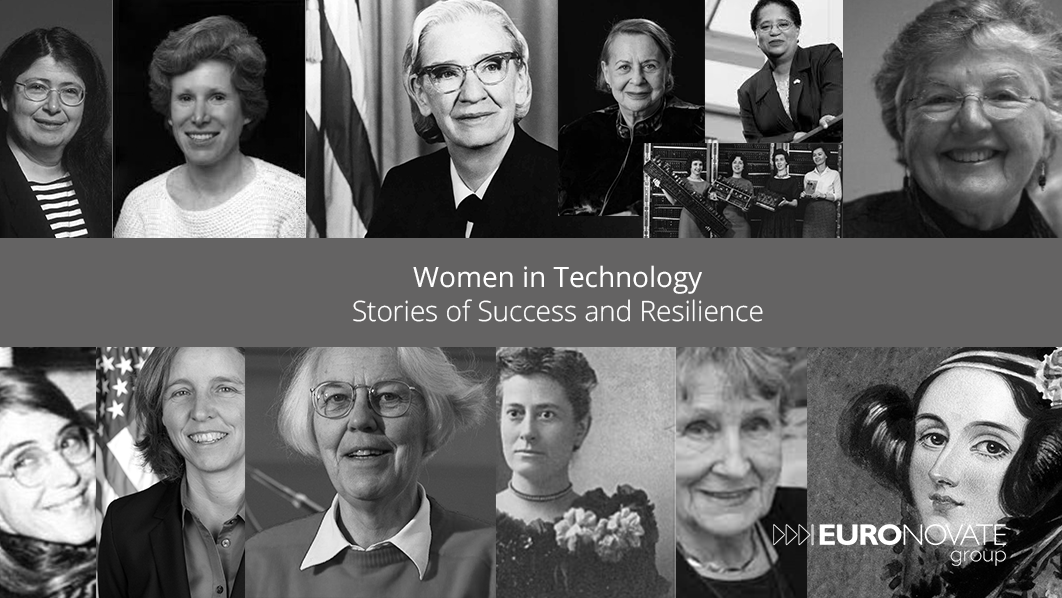Women have played (and do occupy) a vital role in the advancement of technology and computing. Women in the shadows who require our attention and recognition. And not because they ask, no. But because they are an example so that many girls and women can follow in their footsteps on equal terms, and so that all people know that gender does not matter when it comes to working and contributing knowledge to the world.
Today, March 8 International Day of Working Women from Euronovate Group we want to pay our small tribute to the pioneers of the sector so that just as they have already served as an inspiration to girls, they continue to do so to future generations. Here are some of the women who broke barriers and set a milestone in technology.
Ada King Lovelace, the Pioneer

This British countess, born in 1815, was the first person to define a general programming language by interpreting Charles Babbage’s ideas, a Cambridge mathematics professor and father of computers. Lovelace defined concepts such as loop or subroutine and defined the use of punched cards to program a machine created by the English mathematician.
Willemina Fleming, creator of Harvard computers

At the end of the 19th century, the men at the Harvard University Observatory were busy looking up at the sky, collecting data on the planets. No one organized the amount of information collected. The head of the Observatory, Edward Pickering, needed someone to carry out this task. A modest single mother of Scottish origin with no higher education applied. This is how Willemina Fleming created the Harvard Computer Group, a group of ladies who classified more than 10,000 stars. Later she became a renowned astronomer.
The first female programmers: the women of the ENIAC

In 1946, six mathematicians were in charge of programming what would be the first electronic computer developed by the US government, the Electronic Numerical Integrator And Computer (ENIAC). It weighed 27 tons, occupied 167 m2, had more than 17,000 valves, and could perform 300 multiplications and 5,000 additions per second. It was created to calculate ballistic trajectories, and the function of mathematics was to write the programs in the binary system. Carrying out the various operations continuously involved connecting and disconnecting cables.
Grace Hopper, the mother of computing and the creator of the term bug

Mrs. Hopper, who also came from the Army and became an Honorary Admiral in the US Navy, was one of the first great computer programmers, the Mark I. COBOL. She created the term bug by slipping a butterfly into the circuits, causing execution errors. She also applied her computer skills to private companies, making the UNIVAC I, the first business-oriented computer. Her best-known contribution, the compiler language, translates instructions from English into the machine’s internal language. Hopper said, "she believes it out of laziness and pretending that the programmer was more mathematical." She died in 1992.
Karen Spärck Jones, creator of the natural language on which current search engines are based

The search engines we use every day are based on the discoveries made about this British scientist’s natural language. Karen Spärck Jones was recruited to do research in Cambridge by another woman, the computational linguist Margaret Masterman. Both from the Language Research Unit, in the late 1950s, worked on the development of a thesaurus for language processing. The scientific community has highly valued the research work carried out by Spärck Jones, but it was with the Internet’s advent even more.
Mary Allen Wilkes, the woman who brought computing home to us

Born in 1937, Wilkes always wanted to be a lawyer, but her parents wouldn't let her. She ended up graduating in philosophy and working in programming. She was a pioneer when designing the LAP6 operating system from the MIT Laboratory Instrument Computer (LINC). In 1964, her task force moved from Boston to St. Louis, Missouri. She did not want to work there because her mother was ill. The solution was to install the LINC, the size of a refrigerator, at home to work, only needed a phone line. She was the first person to use a personal computer at home and, in a way, a pioneer of teleworking. By the way, Mary Allen Wilkes ended up practicing as a lawyer.
Joan Ball, the driving force behind online dating

Match, the Harvard students project, was not the world's first digital dating system. In 1964, an English woman created the precursor solution to today's Tinder. Joan Ball, worked in a marriage agency, that yes, analog. Seeing the weight that computing was beginning to have, he designed a punch card system looking for the agency’s clients’ attributes they did not want to find in their future partners. The computer crossed the information, and the users received the name and the address of the coming league.
Adele Goldberg, the inspiration for Apple desktops

Goldberg, a mathematician, was a researcher at the Xerox Palo Alto Research Center (PARC) in the mid-1970s. She was the only woman developing the SmallTalk programming language, which was destined to surpass Windows as a graphical user interface (GUI). In a recent interview, Golberg revealed that her superiors at Xerox forced her to show SmallTalk and the interface to a young Steve Jobs and his team who visited PARC in 1979. From the get-go, she said it seemed like a bad idea. Jobs himself acknowledged that the technology in which Goldberg had participated had "paralyzed" him and that it was going to be key in the future of computing and Apple. Perhaps, without Adele's work, the Apple desktop would not have its current appearance.
Margaret Hamilton, developed the navigation ‘software’ for the Apollo Space Program

Margaret Hamilton is a computer scientist, mathematician, and systems engineer. She was director of the Software Engineering Division of the MIT Instrumentation Laboratory, wherewith her team developed the on-board navigation software for the Apollo Space Program. In 1986, she became the founder and CEO of Hamilton Technologies, Inc. in Cambridge, Massachusetts. The company developed around the universal language of systems based on its "development before the fact" (DBTF) paradigm for software design systems. I coined the term "software engineering" to distinguish between hardware and other engineering work. Although his idea was not well received initially, the software eventually generated the same respect as other disciplines.
Evelyn Berezin, promotes word processors and the first airline ticket reservation system

Evelyn Berezin was an American computer engineer. She developed the first airline ticket reservation system for United Airlines. It is also known as the mother of word processors since, in 1968, it developed the idea of a program that allowed storage and edit texts.
Shirley Ann Jackson, first African-American woman to earn a Ph.D. from MIT. He developed fax, tone dialing, fiber optics ...

Shirley Ann Jackson is an American physicist and the eighteenth president of the Rensselaer Polytechnic Institute. He received his Ph.D. in nuclear physics from the Massachusetts Institute of Technology in 1973, becoming the first African-American woman to earn a Ph.D. from MIT. She is also the second African-American woman in the United States to earn a doctorate in physics.
Radia Perlman, the mother of the Internet

Born in 1951, Radia Perlman created the algorithm behind Spanning Tree Protocol (STP), which is a crucial part of the Internet’s underlying foundation. Despite this, he insists that "any individual did not invent the Internet." He currently works for Dell EMC in Seattle, United States, and previously he was working for Intel, for which he obtained more than 47 patents.
Megan Smith, the neutrality of the Internet

Megan Smith, born in 1965, went in 2014 from being vice president of Google to Chief Technology Officer of the United States Government during the Obama administration. For his mission, they gave her a Dell laptop and a blackberry ... and 70,000 million dollars for public management of science and technology. Among its milestones: advising Barack Obama to achieve, in 2015, neutrality on the Internet with the principle of equality for all users, defining access to the Internet as a “public good”.
Frances E. Allen, The first winner of the Turing, was a specialist in improving computer programs’ performance

American mathematician and computer researcher was a pioneer in developing software and creating high-performance computer systems, standing out especially in the creation of compiler programs, which transform the source code of a program to its equivalent in another usually lower-level programming language. Allen spent most of his professional career at IBM, where he worked for 45 years, occupying important positions in the R + D + I department. In 2006, she received the A.M. Turing, being the first woman to receive this award given by the Association for Computing Machinery (ACM). Since 1966 recognizes all those who have excelled in computer science and are known as the "Nobel Prize" in computing. The award was given to her for "her pioneering contributions to the theory and practice of optimizing compilation techniques that laid the foundation for modern compiler optimization and automatic parallel execution."
Are you passionate about digital?
Do you want to stay up to date with our latest news and posts about Digital Transformation?
We are on Twitter and LinkedIn. Follow us!





